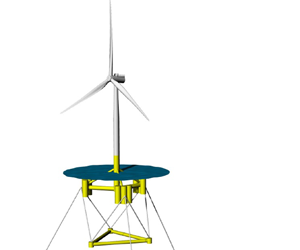Crossref Citations
This article has been cited by the following publications. This list is generated based on data provided by
Crossref.
Bruschi, Niccolo
Ferri, Giulio
Marino, Enzo
and
Borri, Claudio
2020.
Influence of Clumps-Weighted Moorings on a Spar Buoy Offshore Wind Turbine.
Energies,
Vol. 13,
Issue. 23,
p.
6407.
Ferri, Giulio
Marino, Enzo
and
Borri, Claudio
2020.
Optimal Dimensions of a Semisubmersible Floating Platform for a 10 MW Wind Turbine.
Energies,
Vol. 13,
Issue. 12,
p.
3092.
Rijnsdorp, Dirk P.
Wolgamot, Hugh
and
Zijlema, Marcel
2022.
Non-hydrostatic modelling of the wave-induced response of moored floating structures in coastal waters.
Coastal Engineering,
Vol. 177,
Issue. ,
p.
104195.
Gao, Zhi-teng
Feng, Xing-ya
Zhang, Zi-tan
Liu, Zheng-liang
Gao, Xiao-xia
Zhang, Li-jun
Li, Shan
and
Li, Ye
2022.
A brief discussion on offshore wind turbine hydrodynamics problem.
Journal of Hydrodynamics,
Vol. 34,
Issue. 1,
p.
15.
Xu, Zhijing
Bi, Chun-Wei
and
Ma, Chao
2023.
Nonlinear dynamics of an aquaculture cage array under oblique wave attack.
Ocean Engineering,
Vol. 288,
Issue. ,
p.
115948.
Veers, Paul
Bottasso, Carlo L.
Manuel, Lance
Naughton, Jonathan
Pao, Lucy
Paquette, Joshua
Robertson, Amy
Robinson, Michael
Ananthan, Shreyas
Barlas, Thanasis
Bianchini, Alessandro
Bredmose, Henrik
Horcas, Sergio González
Keller, Jonathan
Madsen, Helge Aagaard
Manwell, James
Moriarty, Patrick
Nolet, Stephen
and
Rinker, Jennifer
2023.
Grand challenges in the design, manufacture, and operation of future wind turbine systems.
Wind Energy Science,
Vol. 8,
Issue. 7,
p.
1071.
Zeng, Xinmeng
Shi, Wei
Feng, Xingya
Shao, Yanlin
and
Li, Xin
2023.
Investigation of higher-harmonic wave loads and low-frequency resonance response of floating offshore wind turbine under extreme wave groups.
Marine Structures,
Vol. 89,
Issue. ,
p.
103401.
Pollini, Nicolò
Pegalajar-Jurado, Antonio
and
Bredmose, Henrik
2023.
Design optimization of a TetraSpar-type floater and tower for the IEA Wind 15 MW reference wind turbine.
Marine Structures,
Vol. 90,
Issue. ,
p.
103437.
Zeng, Xinmeng
Shao, Yanlin
Feng, Xingya
Xu, Kun
Jin, Ruijia
and
Li, Huajun
2024.
Nonlinear hydrodynamics of floating offshore wind turbines: A review.
Renewable and Sustainable Energy Reviews,
Vol. 191,
Issue. ,
p.
114092.
Bredmose, H.
Hansen, A.M.
Fiskvik, S.
Merino, D.
Li, H.
and
Gao, Z.
2024.
Efficient calculation of deformation and FEM stress for substructures of floating wind turbines.
Journal of Physics: Conference Series,
Vol. 2875,
Issue. 1,
p.
012027.
Duan, Guiyue
Gattari, Daniele
and
Porté-Agel, Fernando
2024.
Power performance of a model floating wind turbine subjected to cyclic pitch motion: A wind tunnel study.
Journal of Physics: Conference Series,
Vol. 2767,
Issue. 9,
p.
092065.
Yang, Hui
Li, Yihong
Wang, Jun
Ma, Yingchao
and
Xu, Zhijing
2024.
Numerical modeling of an offshore shellfish farm exposed to extreme wave conditions.
Frontiers in Marine Science,
Vol. 11,
Issue. ,
Lynggård Hansen, Christine
Bredmose, Henrik
Vincent, Maude
Steffensen, Stefan Emil
Pegalajar-Jurado, Antonio
Jensen, Bjarne
and
Dixen, Martin
2024.
Resonant response of a flexible semi-submersible floating structure: experimental analysis and second-order modelling.
Journal of Fluid Mechanics,
Vol. 982,
Issue. ,
Borg, M.
Pegalajar-Jurado, A.
Stiesdal, H.
Madsen, F.J.
Nielsen, T.R.L.
Mikkelsen, R.F.
Mirzaei, M.
Lomholt, A.K.
and
Bredmose, H.
2024.
Dynamic response analysis of the TetraSpar floater in waves: Experiment and numerical reproduction.
Marine Structures,
Vol. 94,
Issue. ,
p.
103546.
Duan, Guiyue
Gattari, Daniele
and
Porté-Agel, Fernando
2025.
Theoretical and experimental study on power performance and wake characteristics of a floating wind turbine under pitch motion.
Applied Energy,
Vol. 378,
Issue. ,
p.
124767.

 $1:60$ scale model of the DTU 10 MW reference wind turbine, was subjected to irregular wave forcing (with no wind) and shown to exhibit subharmonic resonant motions, which greatly exceeded the wave-frequency motions. These slow-drift responses are excited nonlinearly, since the rigid-body natural frequencies of the system lie below the incident-wave frequency range. Pitch motion is examined in detail, allowing for identification of different hydrodynamic forcing mechanisms. The resonant response is found to contain odd-harmonic components, in addition to the even harmonics expected a priori and excited by second-order difference-frequency hydrodynamic interactions. Data analysis utilising harmonic separation and signal conditioning suggests that Morison drag excitation or third-order subharmonic potential flow forcing could be at play. In the extreme survival-conditions sea state, the odd resonant responses are identified to be drag-driven. Their importance for the tested floater is appreciable, as their magnitude is comparable to the second-order potential flow effects. Under such severe conditions, the turbine would not be operating, and as such neglecting aerodynamic forcing and motion damping is likely to be reasonable. Additionally, other possible drivers of the resonant pitch response are explored. Both Mathieu-type parametric excitation and wavemaker-driven second-order error waves are found to have negligible influence. However, we note slight contamination of the measurements arising from wave-basin sloshing.
$1:60$ scale model of the DTU 10 MW reference wind turbine, was subjected to irregular wave forcing (with no wind) and shown to exhibit subharmonic resonant motions, which greatly exceeded the wave-frequency motions. These slow-drift responses are excited nonlinearly, since the rigid-body natural frequencies of the system lie below the incident-wave frequency range. Pitch motion is examined in detail, allowing for identification of different hydrodynamic forcing mechanisms. The resonant response is found to contain odd-harmonic components, in addition to the even harmonics expected a priori and excited by second-order difference-frequency hydrodynamic interactions. Data analysis utilising harmonic separation and signal conditioning suggests that Morison drag excitation or third-order subharmonic potential flow forcing could be at play. In the extreme survival-conditions sea state, the odd resonant responses are identified to be drag-driven. Their importance for the tested floater is appreciable, as their magnitude is comparable to the second-order potential flow effects. Under such severe conditions, the turbine would not be operating, and as such neglecting aerodynamic forcing and motion damping is likely to be reasonable. Additionally, other possible drivers of the resonant pitch response are explored. Both Mathieu-type parametric excitation and wavemaker-driven second-order error waves are found to have negligible influence. However, we note slight contamination of the measurements arising from wave-basin sloshing.